It is a widely known fact that personalized product recommendations are one of the main marketing tools of any online store. They help you sell more to every customer. However, sometimes, recommendation engines fail to give relevant recommendations in cosmetics and recommend a wrong type of hair conditioner or hand cream. Sometimes it’s even worse when a person allergic to a certain component is recommended items with that component.
To solve this problem, the market had to come up with the Progressive Personalization technology. Every one of us, as a customer, has a set of unique key parameters a recommendation system must include into its computations to eliminate any chance of error. What it is and how it works you’ll have known reading this post.
Why Regular Personalization Fails for Cosmetics & Beauty Stores
Personalization can rely on different types of approaches. One of the most popular is the Big Data approach. A Big Data-based personalization predicts the consumer demand based on a collective behavior. For example:
A customer is reading the product details of a hand cream by Clinique. Big Data tells the recommendation system that 5000 other consumers bought this cream visiting this product detail page, and 1000 of them also bought a Wella shampoo, at least once. Based on that, the system recommends this shampoo to the given consumer.
Here is where Big Data-based personalization fails. The consumer has oily hair, while the shampoo is designed for people with dry hair. Although, statistically, that recommending decision was not incorrect, as a lot of consumers from this group bought the shampoo, this case shows the major flaw of Big Data-based approaches. The recommendation has no value either to the store or customer.
There is another aggravating factor in this situation: the nature of Cosmetics & Beauty does not allow universal recommending algorithms, as the purchase decision in this retail segment is influenced by a very particular set of key parameters. A man would almost never buy a shampoo designed for women. Dry skin requires specific products, making normal and oily skin products irrelevant to the user. A consumer allergic to certain components would never purchase any products based on any of those components. The list goes on.
The otherwise strong sides of Big Data-based types of personalization, such as statistical analysis and CF (Collaborative Filtering), are useless for individual personalization failing to form the right kind of links and see the relationship between the events.
Key Parameters in Cosmetics & Beauty
A distinctive feature of Cosmetics & Beauty that differentiates it from any other retail segment is highly individual purchase decisions that are influenced by a great variety of user parameters:
- Gender
- Product hypoallergenic properties in cases of personal allergies.
- Skin type. To be regularly bought, the product must fit the skin type.
- Skin current condition. To be regularly purchased, the product must also fit the current condition of the skin.
- Hair type. To be regularly bought, the product must fit hair type.
- Current hair condition. To be regularly bought, the product must also fit current condition of the hair.
- The purpose of use.
- Place of application. Full body, face, hair, hands, feet, intimate areas, etc.
- Brand. Individual brand preferences.
- Purchase frequency. Cosmetic products are often consumables, and so require frequent repurchasing.
Progressive Personalization is a cutting edge technology that relies on a thorough customer behavior analysis. Every event – every browsing click, adding to the cart, purchasing — affects the recommendation improving their relevance to the buyer. The tech is constantly updating the customer profile with the new data and confirming hypotheses to determine the key parameters, such as the gender, hair type, skin current condition and so on, to exclude irrelevant offers from the recommendations.
Now, let us have a look at some common mistakes in targeting and personalization in Cosmetics & Beauty.
Incorrect Personalization
Cosmetic products are designed to take into account many various physiological parameters. This is a retail segment where one product cannot possibly “fit all.” Numerous online stores repeat the same mistake: they choose to ignore customer’s individual physiological parameters.
Skin Type
For instance, Flipkart sells a body butter for dry skin:
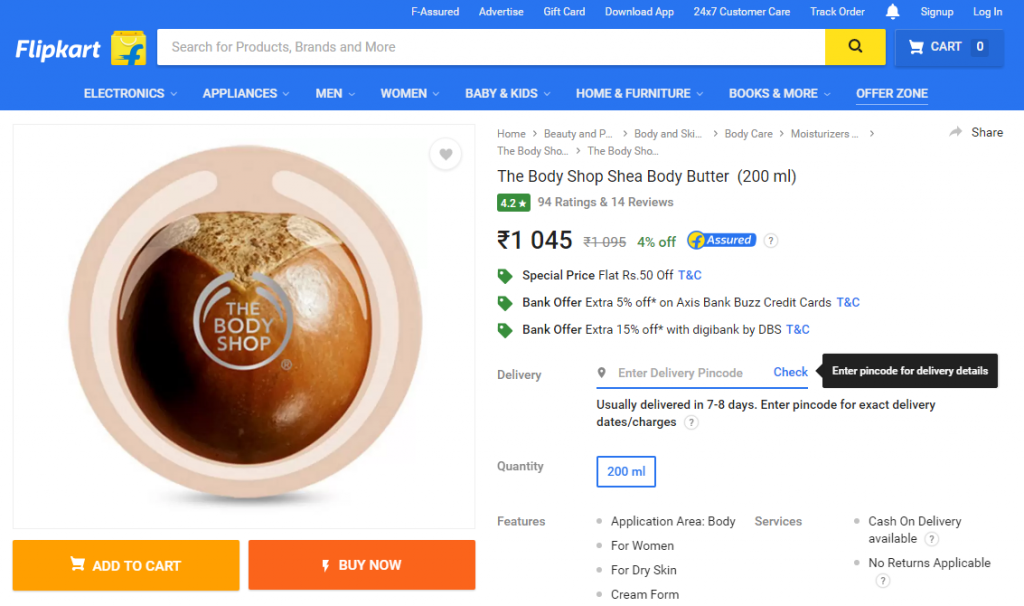

Product recommendations, nevertheless include products for other skin types — sensitive, for example:
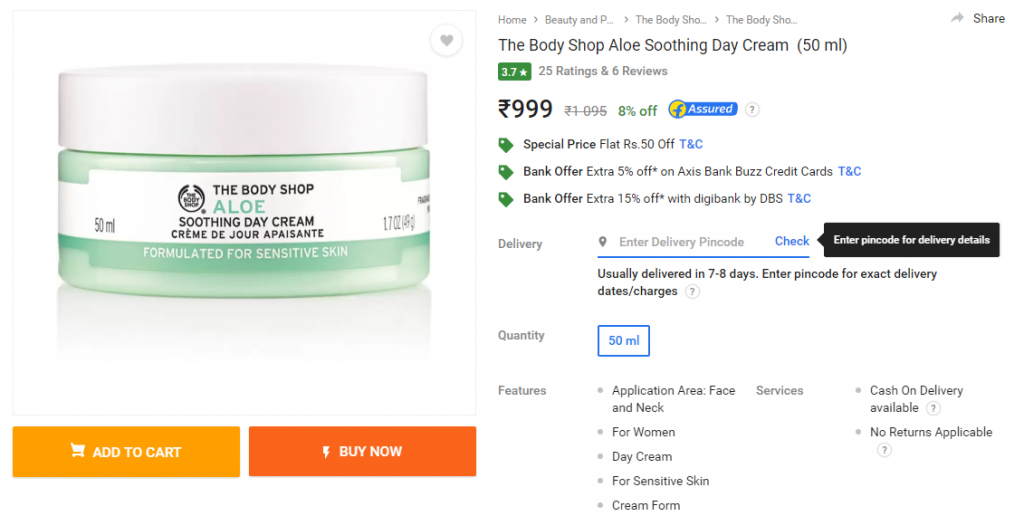 Hypoallergenic Properties
Hypoallergenic Properties
Dermstore features a line of gluten-free products – for consumers allergic to gluten.
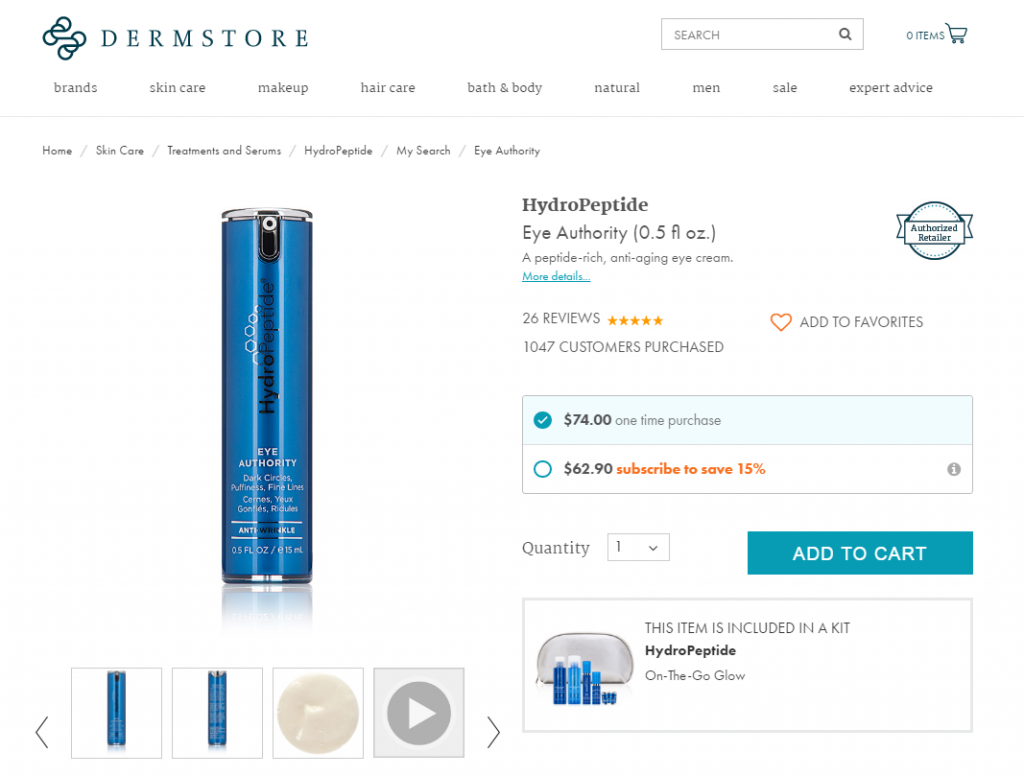
Customers can filter out unsuitable options to see only gluten-free items. Recommendations on the product detail page, nevertheless, can ignore customer’s choice:
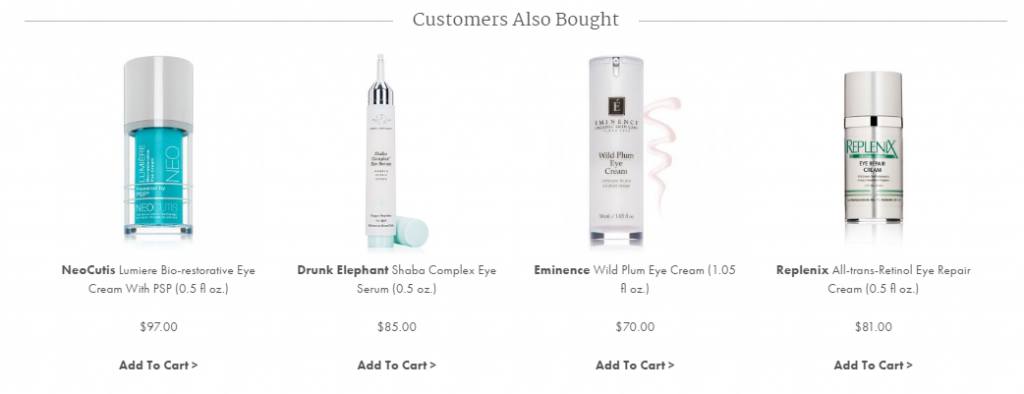
Not a single recommended product is gluten-free, although they still have some very distinct characteristics limiting the target group:

Given the fact that every cosmetic product is highly individual, it is evident that this recommendation is a mere placeholder, and are of no value to the visitor
Progressive Personalization
As said before, hair and skin type are key parameters influencing the final purchase decision. To provide a proper level of personalization, the system must include them into its computations.
If the customer, for instance, is browsing various shampoos for oily hair in Target’s catalog, the Progressive Personalization-driven recommendations will show products for the same (or fitting all types) hair type.
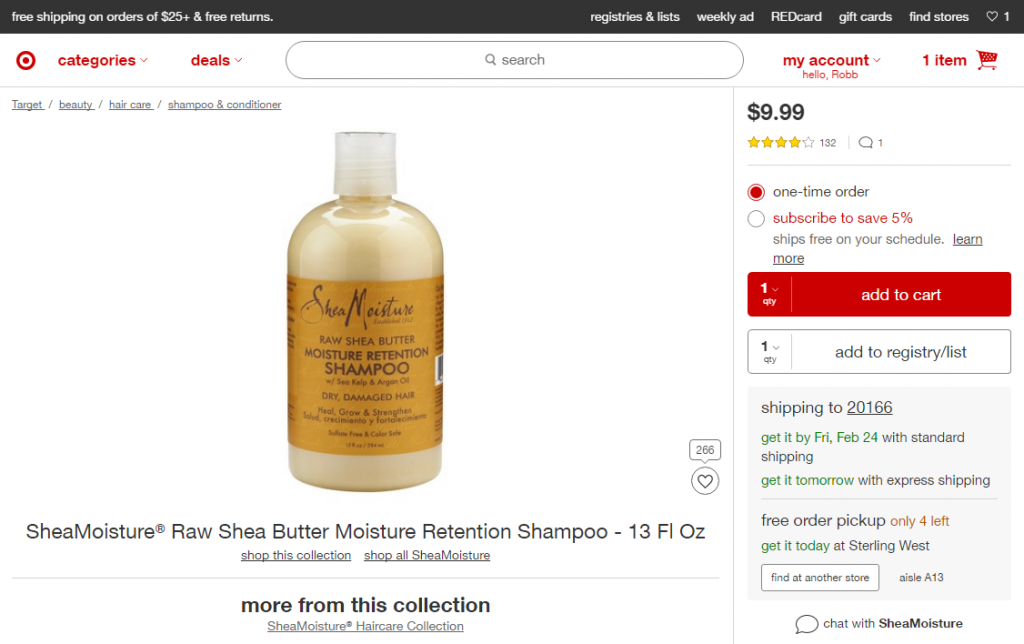
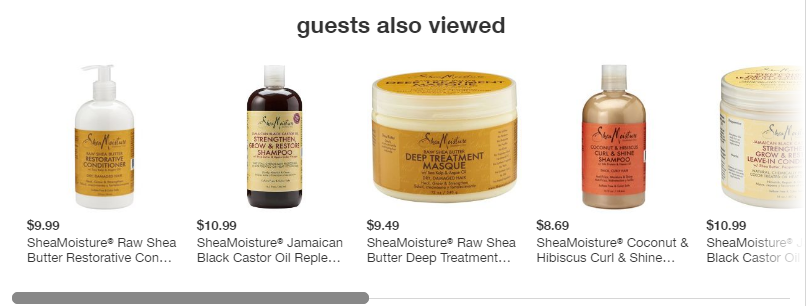
Another two key parameters are a customer’s gender and brand preferences.
A correct type of personalization takes into account both these parameters.
Let us look at this example of the David Jones multi-category store:

As you can see, product recommendations are rendered based on both the first chosen brand and the visitor’s gender.
 Every cosmetic product is designed for a particular place of application: face, hands, intimate areas, feet, etc.
Every cosmetic product is designed for a particular place of application: face, hands, intimate areas, feet, etc.
Combined with the affinity for a certain brand, this factor causes customers to stay with one brand, buying skin care sets for various purposes.
Nordstrom takes this into account. When the visitor chooses a Jack Black beard oil:
 The product recommendations first feature alternative brands (as explained, the customer’s opinion can be swayed by brand preferences); and then a dedicated recommendation block with various purpose and application products of the same brand (an antiperspirant, face scrub, cleanser, and a combined care set).
The product recommendations first feature alternative brands (as explained, the customer’s opinion can be swayed by brand preferences); and then a dedicated recommendation block with various purpose and application products of the same brand (an antiperspirant, face scrub, cleanser, and a combined care set).

It is essential to emphasize how different Cosmetics and Beauty is from any other retail segment, and how many various parameters should be included in calculations to reach an adequate level of personalization. Another complication is that products in this segment can easily cause an allergic reaction, or otherwise negatively affect user’s health.
Underlying Mechanics
To understand the logic behind Progressive Personalization in Cosmetics & Beauty, let us take a look at the underlying mechanics of the calculations of each key parameter.
REES46 Technologies devised its computational algorithms for Cosmetics & Beauty stores.
Gender
Progressive Personalization rule: A lot of cosmetic products are designed specifically for men or women. Female customers almost always shop for themselves, and so do males. Recommended products should, therefore, correspond to the gender.
The first step is to add gender parameters to your XML Product Feed. Mark your products as men’s or women’s, or unisex:
| Product | Gender targeting |
| Paolo hand lotion | Men’s |
| Grapeful shampoo | Unisex |
| Ski Race shaving gel | Men’s |
| Wish face pack | Unisex |
| Lip Lap lipstick | Women’s |
| Chelsea Lee finishing powder | Women’s |
The next step is to track the visitor’s browsing history and determine what products are viewed most often:
| Visitor | Browsed products |
| N001 | Men’s |
| Women’s | |
| Men’s | |
| Men’s | |
| Women’s | |
| Unisex | |
| Men’s | |
| Men’s | |
| Men’s | |
| Unisex |
Unisex products are not to be included in further calculations:
| Mens’ | 6 |
| Women’s | 2 |
It is now time to calculate the gender probability. There is 75% probability that this visitor is a male:
| Mens’ | 6 |
| Women’s | 2 |
| Probability it’s a man | 75.00% |
| Probability it’s a woman | 25.00% |
| Gender | Male |
Our experience shows that optimal probability level is 75% and higher. If it is less than this, the algorithms need a few more tracking records.
Progressive Personalization is designed to determine a visitor’s gender on the go – right from the first minute.
For a more reliable result, we need to include into the calculation different types of events: browsing, pre-purchase and purchase. All three types have a different importance level: the lowest level – a single view; the highest level – a purchase.
This type of approach allows you to avoid possible mistakes. For instance, when a man is browsing women’s products in search of a better gift idea for St. Valentine’s Day.
A more detailed event map is presented below:
| Product | View | Cart | Purchase |
| Ski Race shaving gel | Men’s | ||
| Tulip nail polish | Women’s | ||
| Paolo hand lotion | Women’s | ||
| Wish face pack | Women’s | ||
| Lip Lap lipstick | Women’s | ||
| Chelsea Lee finishing powder | Women’s | ||
| Bison deoroller | Men’s | ||
| Tonitros body lotion | Men’s | ||
| Grapeful shampoo | – |
Every visitor action has a certain level of importance:
| View | 1 |
| Cart | 5 |
| Purchase | 10 |
Then we attribute scores to each event and calculate the sum:
| Men’s | 7 |
| Women’s | 26 |
| Probability it’s a man | 21,21% |
| Probability it’s a woman | 78,79% |
| Gender | Female |
Conclusion — the visitor is a female, and product recommendations should feature women’s products.
Type, Condition and Hypoallergenic Properties
Progressive Personalization rule: A lot of cosmetics are designed for certain skin and hair types (and conditions). A proportion of all customers may have an adverse reaction to certain ingredients, and for them, hypoallergenic properties are a key purchasing factor. Recommended products should correspond to the skin and hair type and current condition, and be mostly hypoallergenic (for customers with allergies).
Skin and hair type and current condition, as well as a predisposition to any allergies, can also be calculated based on the browsing events.
Your store tracks the visitor’s browsing history. Given that all products in the product catalog have been marked according to the targeted gender, hypoallergenic properties, skin and hair type and current condition, the following table is built:
| Product | Gender targeting | Hypoallergenic? | Skin type | Hair type |
| Hand cream | Women’s | Dry | ||
| Foot cream | Women’s | 1 | Normal | |
| Body lotion | Women’s | 1 | Normal | |
| Shampoo | Women’s | Oily | ||
| Conditioner | Women’s | Oily | ||
| Shower gel | Unisex | Normal | ||
| Shaving gel | Men’s | 1 |
Based on this data, your store calculates the visitor’s key properties: The visitor is a woman, allergic to a certain ingredient, with normal skin type, dry skin on hands and oily hair.
| Parameter | Value | Reason |
| Gender | Woman | The majority of all products are designed for women |
| Relationship status | Has a partner | Shows a basic interest in products for men |
| Allergies | Yes | Some of the products are hypoallergenic |
| Hair type | Oily hair | Shampoo and hair conditioner for oily hair |
| Skin type | Normal skin | Foot cream and body lotion for normal skin |
| Hand skin type | Dry skin | Hand cream for dry skin |
The same logic is applied to other key parameters. You can introduce more markers to your product catalog to reach an even higher level of personalization. The more detailed the event map, the more relevant and individual the recommendations that will appear.
As you will have noticed, there is an extra parameter deduced in the process: relationship status. One of the viewed items was a men’s product. It also gives the store an opportunity to include men’s products into personal recommendations for this woman before any big holidays; for instance, a skin care set for men.
Progressive Personalization in Your Cosmetics & Beauty Store
Instead of relying just on purchase statistics, the Progressive Personalization technology strongly relies on the individual parameters of each visitor to deliver highly relevant recommendations in real time.
This tech doesn’t require a “black box” logic but follows clear and reasonable patterns ready to be implemented into your store from scratch. Progressive Personalization performs equally well without Big Data or coupled with it to deliver the superior level of personalization to every customer.
Check REES46 Cosmetics and Beauty personalization solution here.
